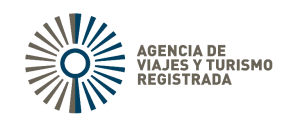Machu Picchu Guide 2025: Everything You Need To Know
Here is a 2025 up-to-date guide to Machu Picchu, where people from all over the world venture for a shared dose of awe and awakening. This comprehensive guide covers everything from Machu Picchu circuits and maps to tours, tickets, and essential visitor information. No photograph or description can capture the experience. You must be there for that moment when you first set eyes on the monumental Inca architecture perfectly perched between two craggy mountain peaks. Now read this Machu Picchu guide for 2025.Schedules and Circuits to visit Machu Picchu in 2025
Where is Machu Picchu?
The Machu Picchu Sanctuary is located 45 miles (73 km) from the Plaza de Armas of Cusco, Peru, South America. The nearest population center — and main gateway to the ancient citadel — is the town of MachuPicchu Pueblo, more commonly known as Aguas Calientes. There is no direct road access to this small bustling town, so the only way to get to it is by train or on foot. The main entrance to Machu Picchu stands at an elevation of 8,000 feet (2,438 meters) above sea level, on the mountaintop above Aguas Calientes. Given its location within the Peruvian Andes, it makes for an ideal stop when visiting nearby Cusco. There are several different ways of traveling through the mountains to reach Machu Picchu, such as hiking the Inca Trail or traveling by luxury train. Here at Fertur we offer both options with our various Peru Package Tours, which are customized for you depending on your own interests and travel tastes.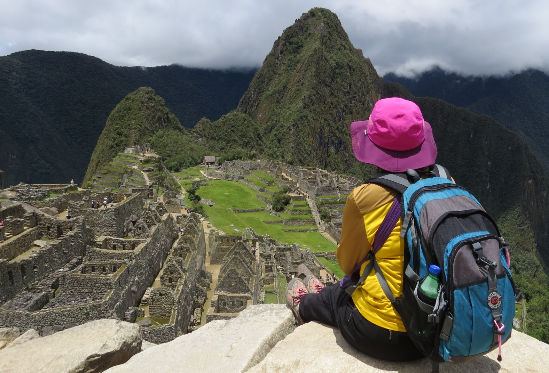
How long does it take to get up to Machu Picchu?
To get up to the sanctuary, you can choose between a 75-minute to 2-hour hike (how long depends on your fitness) or boarding one of the buses that depart from Aguas Calientes every five minutes between 5:30 a.m. and 3:30 p.m. The buses take about 25 minutes to ascend the switchback Hiram Bingham road. Tickets for the bus are sold adjacent to where the vehicles depart, but there are often long lines. Also, Machu Picchu tickets are NOT sold at the entrance gate above.Purchase Machu Picchu entry tickets in person the day before
There is a Ministry of Culture office just off the main square in Aguas Calientes (Machupicchu Pueblo) where a limited number of entry tickets can be purchased one day in advance between 3:30 p.m. and 10:00 p.m. You can go online to reserve these tickets 48 hours ahead of time, subject to availability. But buying them this way, last-minute, is not advisable. Tickets can sell out days — or during the busiest season (June through August) weeks — ahead of time. So it is a good idea to buy both the bus ticket up to the sanctuary and entry ticket into the citadel well in advance. Visitors can also check availability and purchase tickets on Machu Picchu’s official website.Click here to customize your Machu Picchu tour now!
To book your Cusco tours now or consult with us, fill out this contact form and a Fertur Peru Travel coordinator will contact you within one working day with detailed information about your fully customizable trip.
Fertur Peru Travel’s pledge is to offer you top-quality, individualized attention that starts with the planning of your trip and continues through your journey to guarantee a great vacation.
What are the entry times for Machu Picchu?
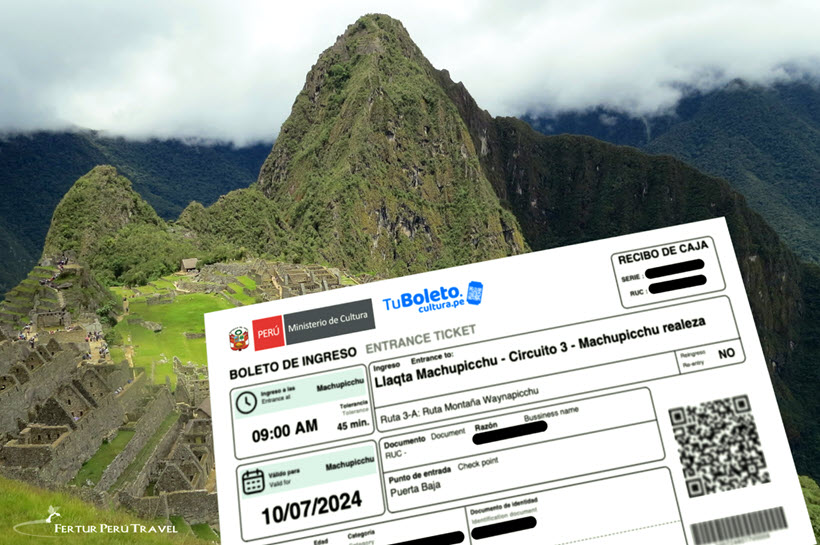
Daily visitor Limits and ticket availability for Machu Picchu
The maximum number of visitors per day is 4,500 during the low season and 5,600 during the high season (June 1 to October 15). One thousand of those tickets are available for sale daily, in person in Machupicchu Pueblo (Aguas Calientes), the town below Machu Picchu. They are sold on a first-come-first-serve basis and can only be purchased one day in advance of entry. However, we highly recommend that you purchase your tickets well in advance of your trip.Is a Machu Picchu Guide Mandatory?
Visitors must be accompanied by a certified guide*, either in private or in small groups, to enter the sanctuary and tour one of four established routes. In addition, visitors can choose ahead of time to purchase entry tickets to climb Machu Picchu Mountain, Huchuypicchu Mountain or the iconic peak of Huayna Picchu. *Note: The rule requiring visitors be accompanied by a certified guide is strictly enforced for groups. The regulation, however, is currently not enforced in practice for individual tourists. Visitors can tour the Inca Citadel without a guide, although one is highly recommended.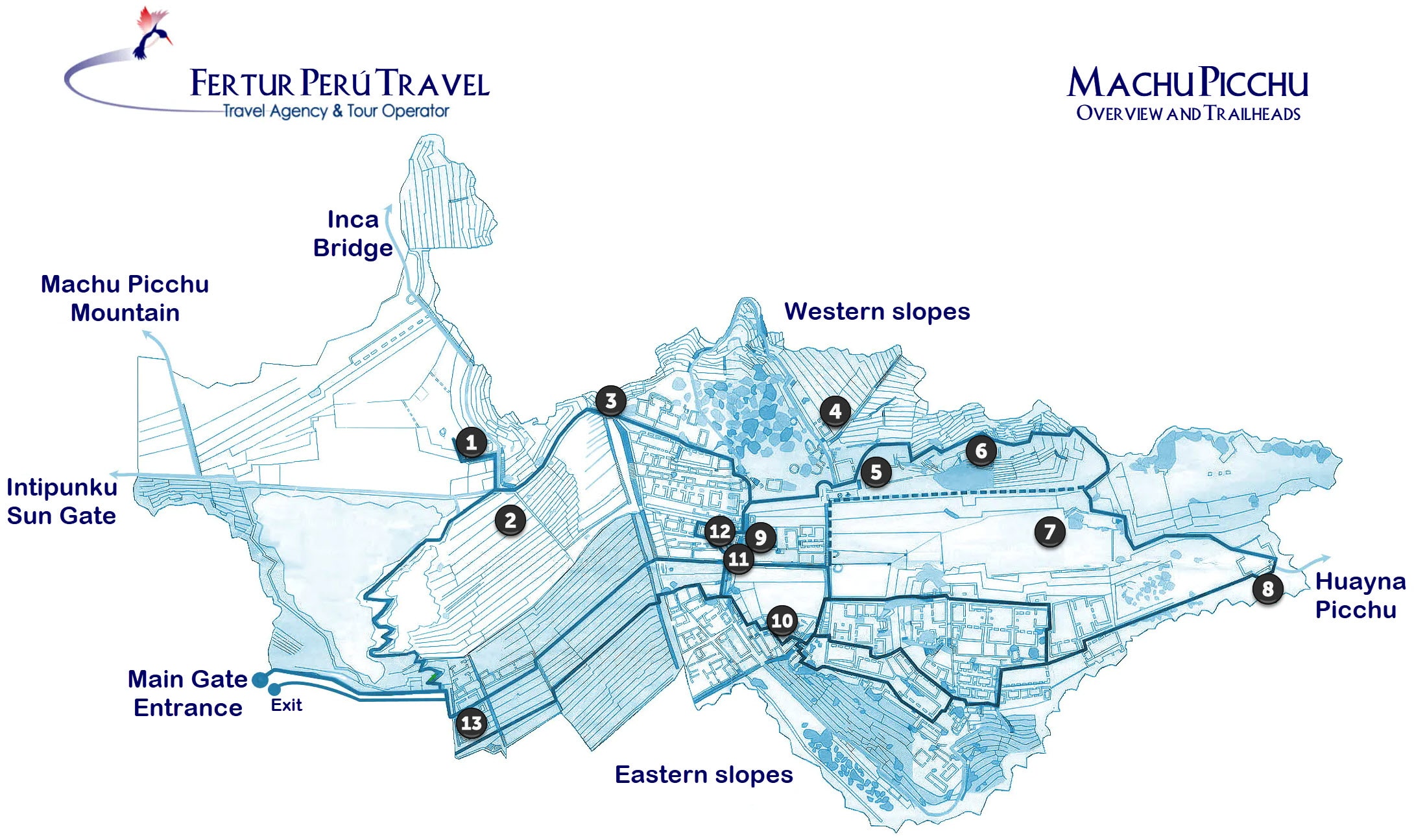
Points of interest:
- Guardhouse
- Agricultural Zone
- Main Gate
- West Agricultural Zone
- Temple of the Three Windows
- Intihuatana
- Main Plaza
- Sacred Rock
- Royal Enclosures
- Temple of the Condor
- Fountains
- Tower
- “Qollca” Storage Houses
How to Stay Safe in Machu Picchu
Overall Machu Picchu is a safe site to visit, as long as you follow the rules which are there to help keep tourists safe. This includes following the marked signs, as well as not passing the ropes. There are lots of stone steps that you will need to walk up and down, so it’s worth bringing comfortable shoes that have good grip (especially if coming in the wet season). If you are bringing children to Machu Picchu, then it’s important to keep them close given what we mentioned above, and also as the site is quite big. It’s also worth taking frequent breaks to rest, which are best done at the different viewpoints when taking photos.Machu Picchu Circuit Map and Routes
As of June 1, 2024, Machu Picchu introduced new tourist circuits to better organize visitor traffic and preserve the archaeological site. There are now three main circuits, each with multiple sub-routes, totaling 10 different options:Machu Picchu circuit #1 (Panoramic Circuit) – Red:
Click to open Machu Picchu Circuit Map 1
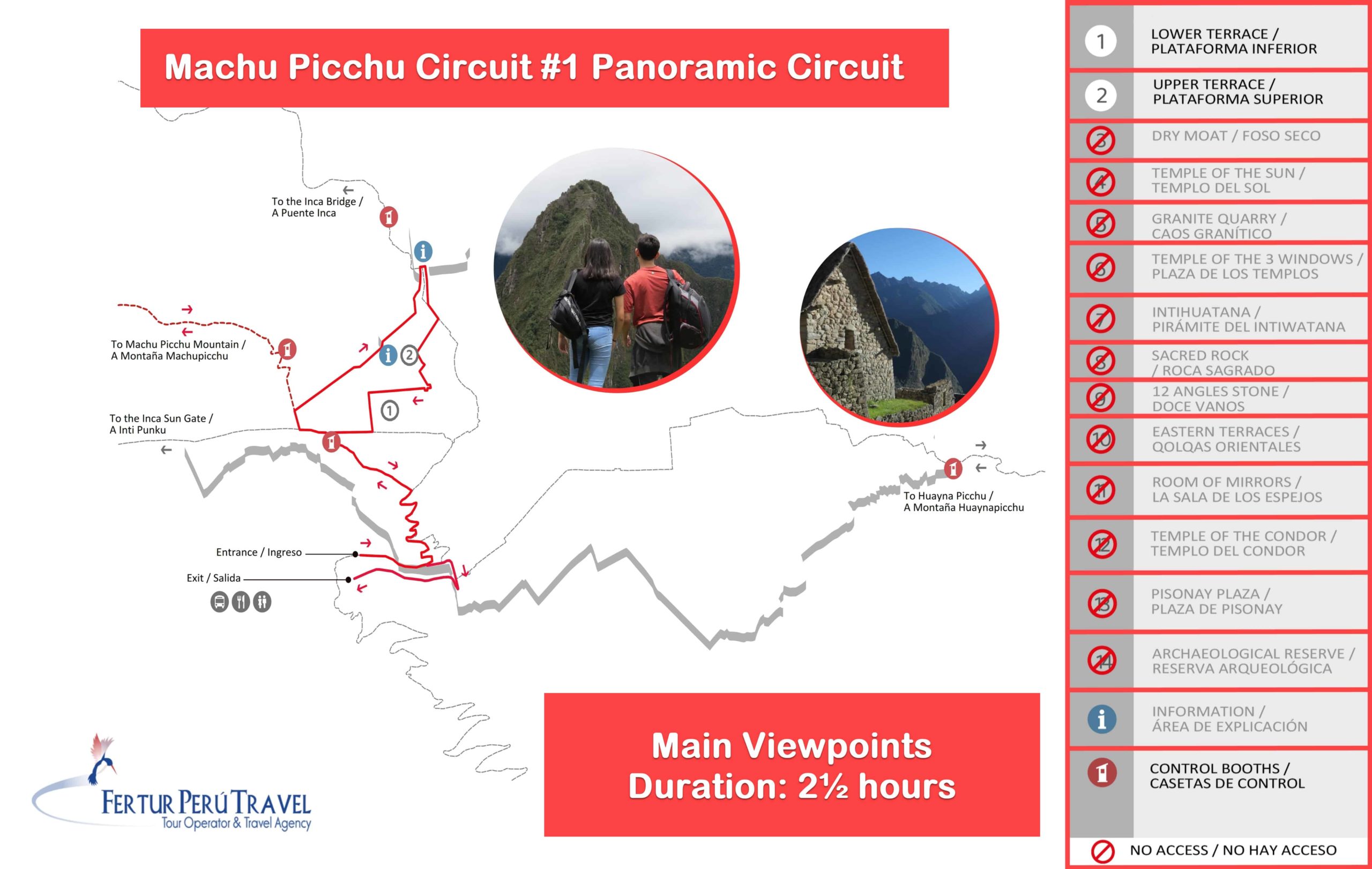
- Route 1-A: Upper Terrace + Machu Picchu Mountain (4-6 hours)
- Includes: Lower platform, Upper platform, Machu Picchu Mountain
- Route 1-B: Upper Terrace (only main viewpoint) (2.5 hours)
- Route 1-C: Upper Terrace + Intipunku (Sun Gate) (3 hours)
- Includes: Visit to Tambo and Pachamama (high season only)
- Route 1-D: Upper Terrace + Inca Bridge (2 hours)
- Includes: View of the Vilcanota Valley (high season only)
Machu Picchu circuit #2 (Inca City Circuit) – Blue:
Click to open Machu Picchu Circuit Map 2

- Route 2-A: Designed Route (Classic) (2.5 hours)
- Includes: Main viewpoint, Granite Quarry, Temple Plaza, Sacred Rock, Twelve-Angle Stone, Eastern Qolqas, Water Mirrors Complex, Pisonay Plaza
- Route 2-B: Lower Terrace Route (Classic) (2.5 hours)
- Includes: Temple of the Sun viewpoint, Temple Plaza, Sacred Rock, Twelve-Angle Stone, Eastern Qolqas, Water Mirrors Complex, Pisonay Plaza
Machu Picchu circuit #3 (Royalty Circuit) – Yellow:
Click to open Machu Picchu Circuit Map 3
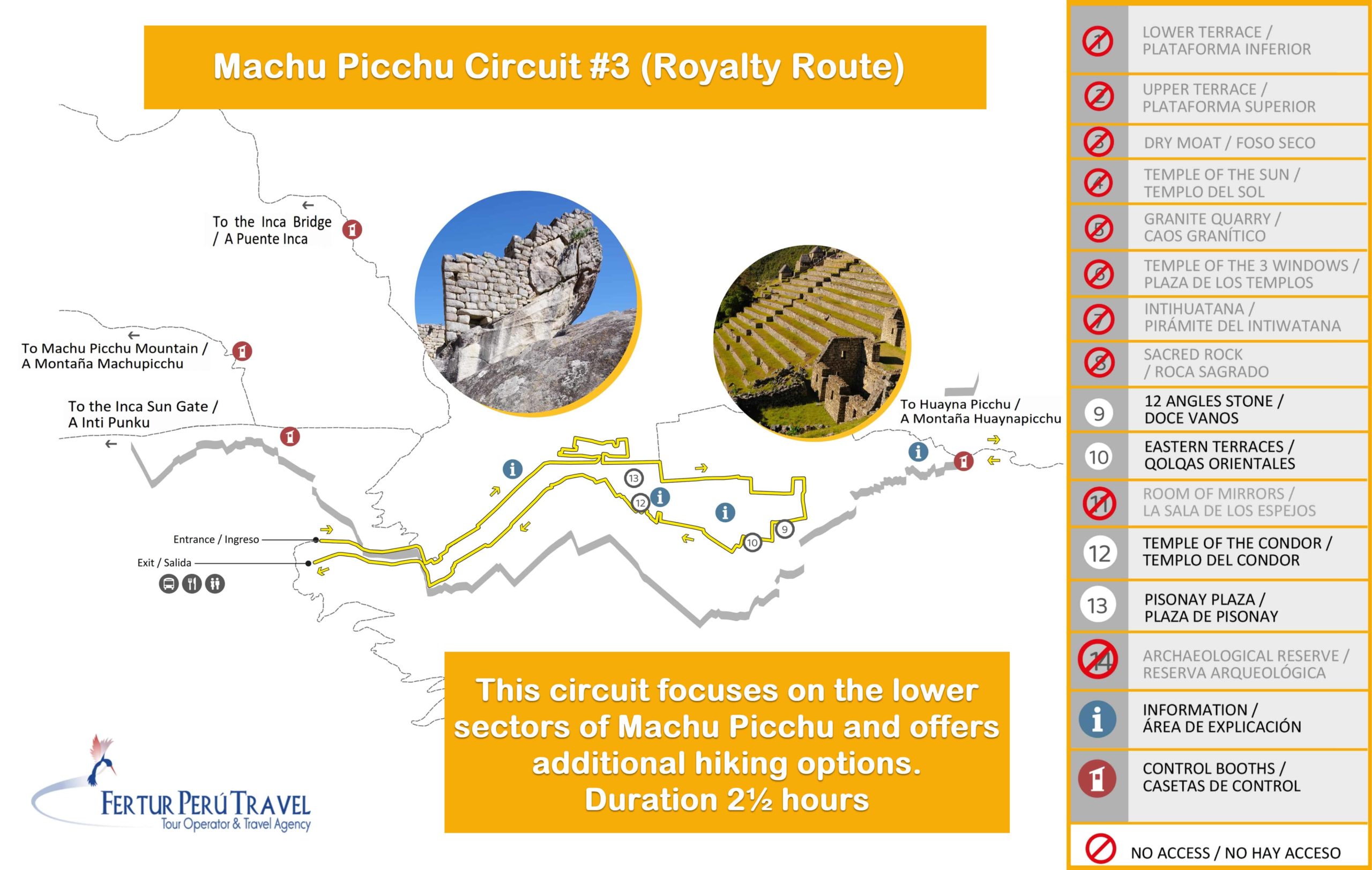
- Route 3-A: Archaeological Center + Huayna Picchu Mountain (additional 3 hours for mountain)
- Route 3-B: Archaeological Center (Designed Route) (2.5 hours)
- Route 3-C: Archaeological Center + Temple of the Moon (Great Cavern) (4 hours) (high season only)
- Route 3-D: Archaeological Center + Huchuy Picchu (3.5 hours) (high season only)
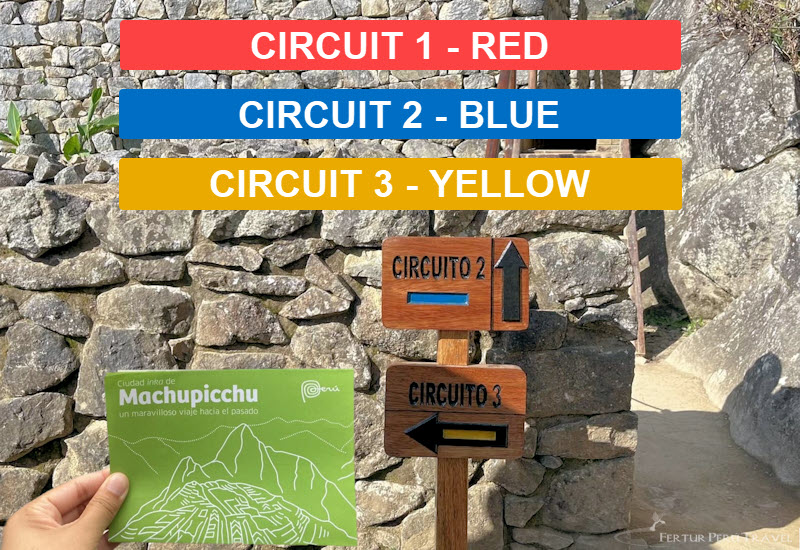
Specific Entry Times for Machu Picchu Hikes
- For tickets that include hikes, there are additional entry windows:
- Machu Picchu + Huayna Picchu:
- Entry from 7:00 AM / Hike from 8:00 AM to 9:00 AM
- Entry from 8:00 AM / Hike from 9:00 AM to 10:00 AM
- Entry from 9:00 AM / Hike from 10:00 AM to 11:00 AM
- Entry from 10:00 AM / Hike from 11:00 AM to 12:00 PM
- Machu Picchu + Mountain:
- Entry from 7:00 AM / Hike from 8:00 AM to 9:00 AM
- Entry from 9:00 AM / Hike from 10:00 AM to 11:00 AM
- Machu Picchu + Huchuy Picchu:
- Entry from 7:00 AM / Hike from 8:00 AM to 9:00 AM
- Entry from 8:00 AM / Hike from 9:00 AM to 10:00 AM
- Entry from 9:00 AM / Hike from 10:00 AM to 11:00 AM
- Entry from 10:00 AM / Hike from 11:00 AM to 12:00 PM
- Entry from 11:00 AM / Hike from 12:00 PM to 1:00 PM
- Machu Picchu + Inca Bridge:
- Entry from 7:00 AM / Hike from 8:00 AM to 9:00 AM
Machu Picchu Hikes and Additional Attractions
Below we can see some of the other more important attractions around Machu Picchu and within the nearby mountains, which includes spectacular peaks and ancient Inca ruins. Here at Fertur Travel we see many of these on our custom Cusco Tours, so be sure to check it out now.Huayna Picchu
The name Huayna Picchu in Quechua means “new mountain.” Rising to 8,763 feet (2,671 meters) above sea level, the summit is girded by Inca buildings, terraces and a shrine on the lower far side, the Temple of the Moon. Reaching the top takes about 50 minutes to an hour and requires a hair-raising, difficult ascent up a narrow trail and through a cave tunnel. Steep granite steps at the top put you literally on the edge of the abyss. The hike sets out from the Sacred Rock at the far north end of the sanctuary. Only 200 visitors are admitted each day, in four shifts: the first from 6:00 to 7:00 a.m., the second from 8:00 to 9:00 a.m., the third from 10:00 to 11:00 a.m., and the fourth from 12 p.m. to 1 p.m. (Note: After completing this route, visitors are not able to re-enter the citadel.)Huchuy Picchu Mountain
Its name in Quechua, Huch’uypicchu, means “Little Mountain.” Reaching a height of 8,188 feet (2,496 meters) above sea level, that is exactly what this peak is, situated diminutively alongside the towering Huayna Picchu. Despite its relative stature, the moderate hike to the top offers stunning views of Machu Picchu and the surrounding cloud forest. The 1.2-mile (1.9 kilometer) trek takes about 45 minutes to an hour. From the checkpoint, the hike loops around the lower route above the Eastern terraces, up and over the peak and back out over the upper terraces. The visitor limit per day is 200, spaced over nine shifts throughout the day, with the first schedule from 6:00 to 7:00 a.m. and the last from 2:00 p.m. to 3:00 p.m. (Note: After completing this route, visitors are not able to re-enter the citadel.)Machu Picchu Mountain
Towering to 10,044 feet (3,061 meters) above sea level, the Quechua name of this higher peak at the southern end of the sanctuary means “old mountain.” The ascent is technically less challenging than Huayna Picchu, but the hike up is longer and no less arduous. Getting to the summit typically requires 90 minutes to two hours, or longer. But at several points along the way, this trek offers unparalleled views of the Inca citadel framed by Huayna Picchu, with the Urubamba River snaking around it in a horseshoe bend. Once on top, you have a 360 degree panoramic vista of the surrounding mountains. The hike begins above the thatched roof Guard House, along a marked stone path that veers off from the trail that leads up to the Inti Punku. The visitor limit per day is 400, again in two shifts: the first from 6:00 to 7:00 a.m. and the second from 8:00 to 9:00 a.m.Inca Bridge
As with Huayna Picchu and Machu Picchu Mountain, the trail head begins with a warden’s hut where you must sign in and out. It is a fairly easy, albeit, vertigo-inducing trek. Getting to the bridge takes about 20 to 30 minutes over a winding cloud forest trail. The ever-narrowing path offers some spectacular vistas of the surrounding river valley and mountains. Crossing the Inca Bridge itself is strictly prohibited ever since several years ago when one hiker tried and fell to his death. But it is quite a sight. Four logs are loosely laid over a 20-foot (six-meter) gap in a buttressed section of the trail grafted onto the sheer mountainside. This “drawbridge” provided the Inca controlled access to prevent unwanted guests from slipping in from the Aobamba Valley to the west.Inti Punku (Sun Gate)
These ruins located at 8,860 feet (2,700 meters) above sea level mark the end of the line for hikers of the Inca Trail, offering them a well-deserved first magnificent view of Huayna Picchu directly ahead and the magnificent stone citadel spread across the saddle ridge below. Day visitors to Machu Picchu can also enjoy this iconic view. Give yourself 45 minutes to an hour to hike up to the Inti Punku from the sanctuary, setting out to the left of the Guard House along the upper terrace.Inca Trail Access to Machu Picchu
For years, Inca Trail permits entitled trekkers who arrived through the Inti Punku (Sun Gate) to re-enter the Machu Picchu Sanctuary with access to the upper terraces. This offered another chance to take in the iconic panoramic view of the plaza with Huayna Picchu in the background, and to explore the most important points of interest. That changed in June 2022 with a new policy, limiting them to the lower terraces and shrines included in Route 3. Hikers of the Classic Inca Trail are no longer entitled to re-enter the sanctuary after exiting. Trekkers of the Short Inca Trail from KM 104 can return the following day. But for all Inca Trail hikers, in order to return to the upper portion of the sanctuary and tour Routes 1 or 2, they must purchase the additional entry ticket.What should I bring to Machu Picchu?
- Your passport. Do not forget to bring it because you cannot enter without it!
- Your Machu Picchu Entry ticket. There is no way to re-issue one if you forget or lose it.
- A camera with a fully charged battery and lots of space on the memory card.
- Good walking shoes, preferably cross trainers or footwear designed for hiking.
- Water in a non-plastic bottle.
- Sunscreen and a cap or hat.
- A rain pancho (a small fold-able one is fine in case of rain).
Machu Picchu Guide 2025: What should I not bring? (The Rules)
The officials at Machu Picchu have signaled that rules of conduct and a list of prohibited items promulgated since 2017 will be more strictly enforced. Here are the RULES OF CONDUCT and WHAT NOT TO BRING TO MACHU PICCHU!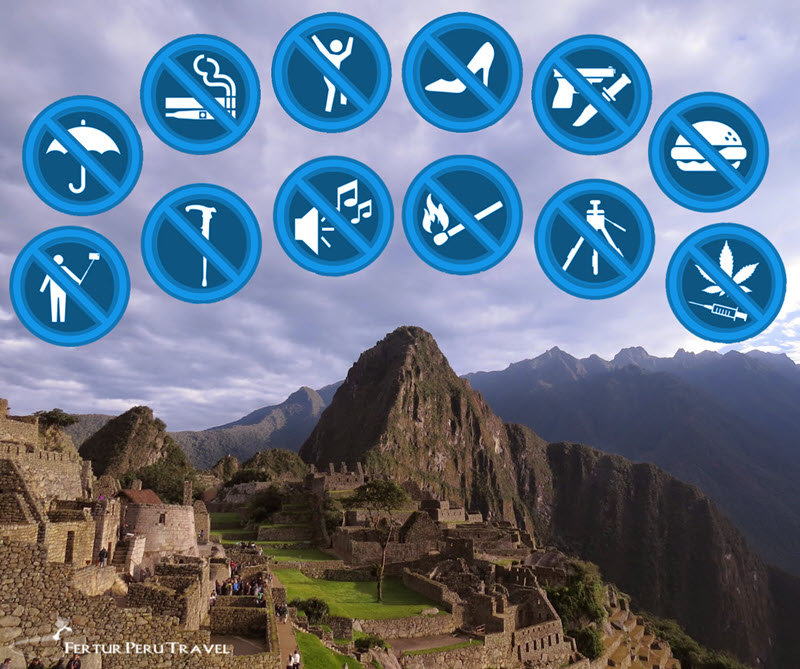
The Do’s and Don’ts at Machu Picchu
Visitors to Machu Picchu are not allowed to... (Click to Expand)
- Carry in plastic bottles
- Carry backpacks, bags or handbags larger than 16 x 14 x 8 inches (40 x 35 x 20 cm). Items that exceed these dimensions must be deposited in the cloakroom storage outside the entrance.
- Enter with food and/or utensils.
- Enter with any illegal substances or under the influence of any illegal drugs.
- Enter with any type of alcoholic beverage or in a state of inebriation.
- Carry umbrellas or parasols. (Caps, hats and raincoats are allowed.)
- Carry tripods, monopods or extensions for cameras, cell phones or any other stabilizing equipment or extension for filming and/or photography, unless authorized by the Department of Culture of Cusco (DDC Cusco).
- Enter with animals, except for guide dogs when strictly necessary.
- Enter with any type of aerosols.
- Enter with any type of musical instrument, megaphone or speakers.
- Use virtual applications with cell phones or mobile devices along any narrow arteries, trails and points of congestion (the use of such technology is allowed only in large open spaces and designated explanation areas).
- Enter with heels or hard-sole shoes (entrance is allowed only with shoes or sneakers that have soft or rubber sole).
- Enter with baby carriages or strollers (only baby backpack carriers with non-metal frames are allowed).
- Enter with sharp instruments and/or weapons of any kind.
- Enter with banners, posters and/or placards, among other objects of this type. (The use of pennants are allowed exclusively for tour guides leading groups of at least 5 visitors and are limited to the model and dimensions determined by competent authorities in coordination with the respective guides).
- Cause disturbances, hop, jump or generate disorder along the entry path to the Machu Picchu Sanctuary and/or at any point within the complex.
- Enter with clothing intended for advertising purposes.
- Climbing or leaning on walls and/or structures.
- Touch, move or extract lithic elements.
- Perform any type of graffiti.
- Disturb, collect or extract native flora or fauna and/or cultural elements.
- Carry out activities that distort the sacred character of the Machu Picchu Sanctuary, such as fashion shows, dances and social engagements, ceremonies of any kind.
- Enter with portable stools or seats, among others.
- Enter with trekking poles with metallic or hard tips (Canes and poles are allowed for use by elderly people or people with obvious physical handicaps, and in general as long as they have rubber tips).
- Carry out any type of activity that implies the impairment or deterioration of the Machu Picchu Sanctuary, its natural environment and/or facilities.
- Obscene acts contrary to morality and good manners.
- Undress, wear costumes, lie down, run and/or jump.
- Smoking or vaping.
- Make loud or annoying noises such as clapping, screaming, whistling, singing, among other actions, because it disturbs the tranquility and the sacred character of the Machu Picchu Sanctuary.
- Make any kind of fire.
- Dispose of waste of any kind.
- Disrespect the established circuits and routes.
- The commercial sales in the interior of the Sanctuary of Machu Picchu and spaces the Puente Ruinas bridge.
- Feed the domestic and wild animals of Machu Picchu Sanctuary.
Compare Trekking Options To Machu Picchu
- Cusco Inca Trail and Machu Picchu 4 days 3 nights
- Short Cusco Inca Trail 2 days 1 nights
- Salkantay Trek & Machu Picchu 5 Days 4 Nights
- Lares Valley Trek 4 to 5 Days

